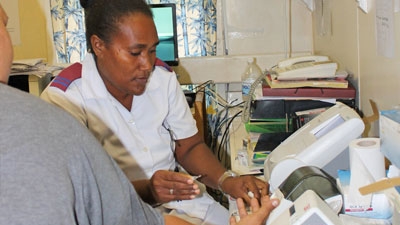Sydney, 16 January 2013 - When people think about health challenges in developing countries, the images that come to mind are of children struggling with parasites, or struck down by infectious diseases like diarrhea, malaria, tuberculosis and HIV/AIDS. But a new health crisis is emerging, and it is taking a particularly heavy toll on people in Pacific Island Countries.
The Pacific region has become one of the world’s hotspots for non-communicable, or “lifestyle” diseases – such as cancer, heart disease, and diabetes. According to Dr. Temo Waqanivalu of the World Health Organization, for an extended family in Pacific Island countries, these diseases will be responsible for eight in every ten deaths. These ailments will strike down people in middle age, or even in their youth.
Suffering from these illnesses is having a major impact on Pacific Islanders. Life expectancy, climbing steadily over the previous decades, dropped in Tonga in 2012 due to the spread of non-communicable diseases (NCDs). Where NCDs do not kill, they can cause poor health and disability, from blindness to amputations. An adult getting sick means he or she may be unable to work, causing drastic loss of income. Too often, children, particularly girls, are forced to drop out of school to care for sick family members.
Non-communicable diseases hit the poorest people hardest
Once associated with people with high social status, NCDs is now common among the population, hitting the poorest people hardest. Getting sick from NCDs traps lower income households in a vicious cycle of poverty. The poor are more vulnerable to illnesses as they have less access to healthy food, education and health services, especially in urban areas. They also tend to consume more tobacco, get less exercise and are less likely to seek out preventive and screening services. The high out-of-pocket costs associated with treatment of often chronic conditions, in turn exacerbate poverty.
A number of known risk factors for NCDs identify smoking, lack of exercise, obesity, and high alcohol use. In a sample of ten Pacific countries, more than 60 percent of the adult population is overweight; as many as two in every three people smoke, while up to seventy percent of adult populations are physically inactive.
As the population ages, the challenges will intensify - and they are likely to be very, very expensive. According to a new report from the World Bank, it is estimated that dialysis for patients with diabetes- related kidney failure cost the Government of Samoa US $38,700 per patient per year in 2010/11. This twelve times higher than the country’s Gross National Income.
It's not only high-tech treatments that impose large costs on health systems. Patients with diabetes require daily glucose testing. While strips only cost US $0.45 cents a day in Vanuatu, the amount is equivalent to $164 per patient per year - amounting to more than the total per capita government expenditure on healthcare. If this burden continues to rise, it cannot be sustained with the current levels of financing.
Government Role in Prevention
“Prevention is better than the cure” is a familiar phrase, and it is particularly apt in the case of NCDs. Governments have an important role to play in increasing public awareness and making health services more affordable.
A broad package of interventions can have significant impact, and lower the direct and indirect costs of NCDs. Among these: providing more and better information about nutrition and the importance of regular exercise, directed particularly at young people and poorer households; ensuring sufficient financing of preventive and primary health care to spot and treat problems early on; and increasing tobacco taxes to reduce the number of new smokers, while simultaneously generating extra revenues for Government. Consideration could also be given to increasing taxes on sugary soft drinks alcohol, and “junk foods” high in saturated and trans fats, and salt content.
Effective prevention of NCDs will have significant health and financial returns, for governments and individuals. It will help protect adults’ ability to work, and ease the burden on prospective careers. Above all, addressing the NCD crisis will support healthier, happier populations across the Pacific.

